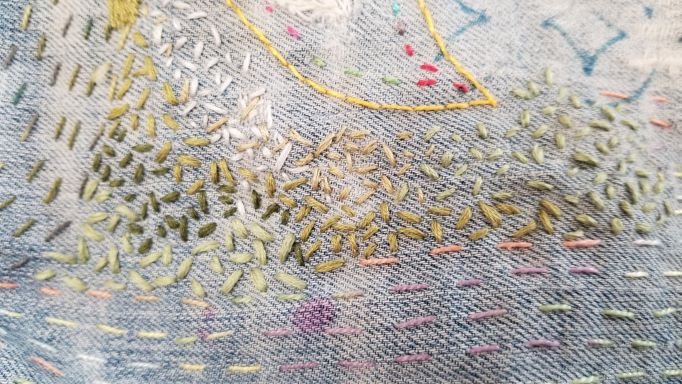My first “visible mended” jeans.
These jeans were purchased for $5 at our local charity shop, ARC, here in Colorado Springs.
Maria giving her butter soft but worn to the point of fragility jeans some love before handing them over to me for repair.
Last year I was inspired by a podcast about the artist Celia Pym who discussed her practice of offering to mend others' beloved articles of clothing, at no charge, just because. Here is the link, if you'd like to listen for yourself.
Shortly afterward, Nard and I were in Camas, Washington, delivering some new art to Attic Gallery. I was wearing my newly stitched visible mended jeans (pictured above) that I had made as an example for my upcoming Green Box Arts Festival workshop, “Visible Mending.”
When gallerist Maria Gonsor exclaimed that I could easily sell the jeans in a local boutique, and that she had some beloved jeans that had been at her seamstress' shop across the street for over six months because the woman was nervous that they would fall apart if she added anymore machine stitching to them, I saw my opportunity to try my hand at Celia's form of generosity.
With the agreement that I would have no time limit on the repair process, as well as complete artistic freedom, Maria collected the jeans and handed them over with trust and faith. Those jeans have since traveled with me from Washington state to Alaska, through Canada, down through North and South Dakota back to Colorado, where they are nearing completion, hopefully in time to mail back to Maria before Christmas.
Maria’s jeans, mending in progress.
But the true inspiration for why I'm telling you about these jeans came from the book “How to be a Craftivist; The art of gentle protest” by Sarah Corbett, which I began reading in 2020 while I was working toward defining the concepts for my art-activist installation “The Clothes We Wear,” calling out the ills of Fast Fashion in a manner I hoped would be informative rather than aggressive. You can re-visit the exhibition here.
In my Oct 19, 2021 blog, “Mending a Sock” I spoke about the shame my generation and earlier ones felt about being seen in public wearing clothes that were second-hand or mended. The increasing acceptance, even pride, current generations exhibit with their endeavors to shop resale and to mend contribute to decreasing landfills, air pollution, water pollution, and greenhouse gas emissions.
Wearing visibly mended clothing with pride promotes normalcy surrounding the idea of re-using and re-imagining one's wardrobe. The clothing invites discussion that can lead to a gentle inspiration to others who may not have considered or been aware of the impact that the fashion industry has on the environment and on third world vulnerable laborers.
More and more, mending our existing clothes and/or those of friends is a trend that is making a positive impact on the fight against the over consumption of cheaply made Fast Fashion clothing.
I’d love to hear from you if you are doing any mending or upcycling. Also, Fyi, I’ve been invited back to teach “Visible Mending” at the 2023 Green Box Arts Festival June 30 - July 15. Subscribe to my e-newsletter to be the first to know when registration opens; last year’s workshop was sold out immediately.
I've been enjoying working slowly but steadily on repairing Maria’s jeans since last March.







